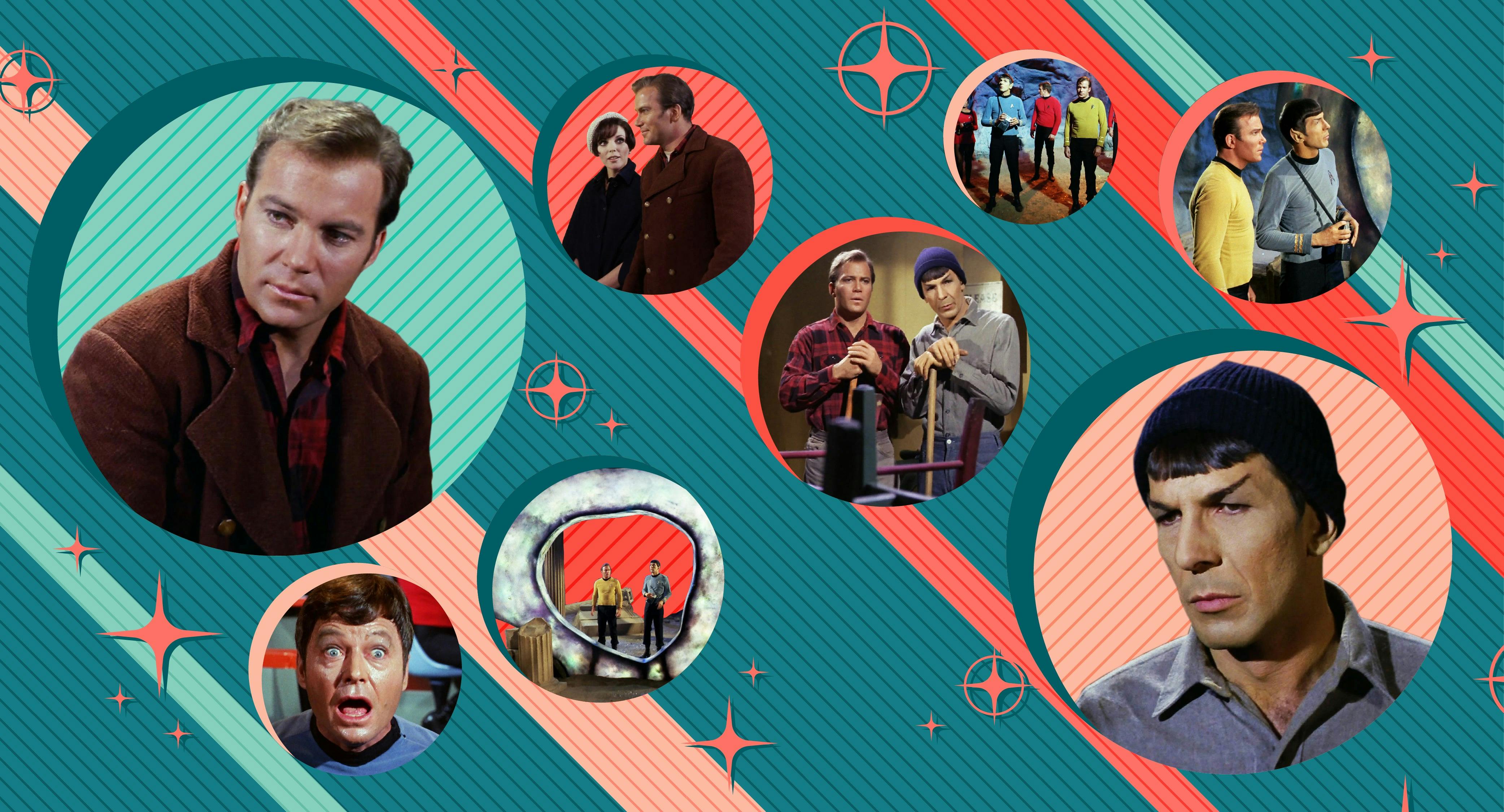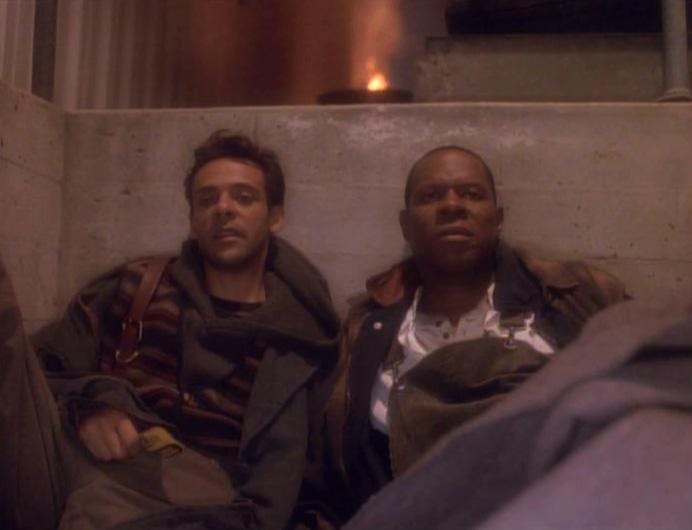Published Apr 6, 2022
The Original Series Episode City on the Edge of Forever Was the Birth of Trekpunk
Let us explain...

StarTrek.com
Harlan Ellison’s “City on the Edge of Forever” is a correctly beloved episode of the classic Star Trek. It’s a bleak story about what can happen when time travel goes wrong, and why the history of the world often moves in cruel and mysterious ways. The story isn’t abstract though, because it puts Captain Kirk’s heart on the line, and in doing so, gives us one of the greatest performances of William Shatner’s entire career. It’s a memorable, and tragic science fiction love story, full of pain and optimism in equal measure.
It’s also got Spock rocking a beanie. While the philosophical nuances and various differences between Ellison's script and Roddenbery’s have been debated ad infinitum, the impact of Spock’s beanie and Kirk’s flannel shirt has been tragically overlooked. What we talk about when we talk about “City on the Edge of Forever,” isn’t just that it was a great episode, but instead, that it gave birth to an aesthetic subgenre within Star Trek. Up until now, that subgenre has never had a name, perhaps, because it’s never been fully identified. But like any subgenre, you know it when you see it. Kirk and Spock rocking their 1930’s outfits, while trying to reverse-engineer Spock’s tricorder, was the birth of a recurring motif I like to call: Trekpunk.

StarTrek.com
What is Trekpunk? Well, you’ve heard of steampunk, right? Spun out of the word “cyberpunk,” steampunk is basically a fictional setting or aesthetic that embraces Victorian (or Edwardian?) anachronisms through science fiction. In some senses, this means there are a few borderline examples of steampunk within Star Trek itself, like, “Time’s Arrow,” for example, which features the TNG crew undercover in 1893, trying to stop aliens in San Francisco, with a little help from Mark Twain. Basically, “Time’s Arrow” was the TNG forerunner to something like Penny Dreadful. Really! Imagine if the crew had been stuck in Earth’s past forever? They would have totally become steampunk defenders of Earth.
But, what I’m proposing is that Trekpunk is a bigger mood than just TNG briefly going steampunk. Trekpunk is that moment when in “City on the Edge of Forever,” when Spock makes Kirk go grocery shopping to buy him some 1930s knickknacks in order to reboot his 23rd-century tech, using what Spock calls is equipment that “isn’t very far ahead of stone knives and bearskins.” It’s a good joke and sort of Spock’s inverted version of the famous Arthur C. Clarke axiom, “Any sufficiently advanced technology is indistinguishable from magic.” In Spock’s corollary, is that any tech that predates the microchip is basically barbaric. It’s a good joke, but what makes the Trekpunk trope so fun is that our Trek heroes have to work with what they have, while occasionally dazzling an unsophisticated time period with a little future-world know-how.
In Star Trek IV: The Voyage Home, Spock trades his beanie for a DIY headband, and Bones complains that the 1986 hospital is like “the Dark Ages.” In the Star Trek: Voyager episode, “Future’s End,” the crew attempts to infiltrate Los Angeles circa 1996, and Tom Paris gives Tuvok grief for not taking his shirt off on the beach. And in First Contact, Troi’s unfamiliarity with “something called tequila” leads her to “blending in” with the human population of the mid 21st century.
In all of these examples, time travel serves as a classic fish-out-of-water story, which, as most people know, is comedy gold. Half of Back to the Future’s jokes rely on the audience knowing something the time traveler doesn’t, and when Trekpunk succeeds, it does the same thing. “What does it mean, ‘exact change’?” Spock bemoans after he and Kirk are kicked off of a city bus. But, what makes Trekpunk explicitly different from other time travel humor, is that we, the audience, are equally familiar with the retro-time period as we are with the future-tense of the Trek time travelers. The novelty is, in part, seeing our favorite Starfleet characters in clothes that make them look a little more like us. If your favorite outfit Bashir ever wore was his duster from “Past Tense,” then you know what I’m talking about.

StarTrek.com
Trekpunk began with “City on the Edge of Forever” because it was the first Trek time travel story in which the characters stayed in a past time period for a while. In “Tomorrow is Yesterday” (which preceded “City” in Season 1 of TOS) Kirk and Sulu don’t really stick around in the ‘60s long enough to have to change clothes. In “City on the Edge of Forever” not only do Kirk and Spock change clothes, but they also get jobs. One of the coolest images from this episode is the moment where Bones and Spock narrowly miss each other, and we see Spock, diligently, and kindly, serving soup. It’s a moment where the realism of Kirk and Spock squatting in the past actually sets in. By Season 2, TOS would have its Trekpunk routine perfected into a schtick. But, Spock’s bucket hat in “Assignment: Earth” is no match for his beanie in “City on the Edge of Forever.”
As a subgenre within Star Trek, Trekpunk is unique because unlike the holodeck-gone-amok historical story (like “A Fistful of Datas”) a true Trekpunk story — like DS9’s “Little Green Men” — makes the stakes more about the people and less about the technology. Because we’re so used to Sisko or Kirk calling their ship and getting beamed away, the Trekpunk storyline not only takes away the communicators, it takes away Starfleet itself. One of Star Trek’s most profound ideas is the notion of the egalitarian Federation. But, in a Trekpunk storyline, Spock, or Sisko or Janeway have to figure out what those values look like before society wises up. In “Past Tense,” the spiritual successor to “City on the Edge of Forever,” Sisko straight-up creates the future by becoming the historical figure we needed in the past.
In The Voyage Home, Bones says “It’s a miracle these people got out of the 20th century.” It’s a joke. We laugh, but we also laugh bitterly, because we’re still worried about getting out of the 21st Century. We love seeing our favorite fictional people try to fit in. But, the power comes from what anachronism represents. Spock in a beanie or Sisko in a trench coat isn’t just about Trek characters looking awesome. It’s about the idea that Trek characters could literally visit us, and meet us on our terms. If Spock and Kirk were dressed like us, what would we have to say to them? Could we live up to what they represent? Trekpunk brings the sartorial vibe of the Final Frontier down to Earth. But, in doing so these kinds of stories, lift us up.
What the visual aesthetic of “City on the Edge of Forever” proved was simple. Not all optimism looks the same. Sometimes the hopeful future wears spandex. Sometimes, it wears flannel.
Ryan Britt is the author of the forthcoming book Phasers On Stun! How the Making and Remaking of Star Trek Changed the World, out from Plume Books (Penguin Random House) in June 2022. He lives in Portland, ME with his wife and daughter.

